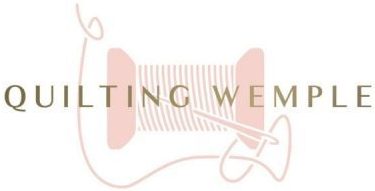So you’re working on a project. You’re in the groove, free motion quilting like a champ. And then all of a sudden the quilt gets hard to move and your thread breaks.
You start again and immediately the thread gets tangled up and breaks again before you’ve even really started.
20 minutes later, you are still struggling to figure out why the thread keeps breaking and you are ready to throw the entire sewing machine out the window.
Instead you opt to go do laundry instead, frustrated and annoyed, maybe even disappointed.
Thread breaking can be tricky since there are just so many reasons it happens, and not every reason is super obvious just by looking at the machine.
Today we’re going over 9 common reasons why your thread keeps breaking during FMQ and how to fix it so you can avoid that laundry a little longer and get back to sewing faster.

How to Handle Thread Breaking While Quilting
Ideally you want as little starting and stopping as possible throughout the center of your quilt, but there are going to be times where it is unavoidable.
Whether you run out of bobbin thread or it breaks for no good reason, you’ll have times where you need to handle thread ends in the middle of your quilt.
Here’s my quick process for starting and stopping in the middle of a quilt when my thread breaks:
- Cut the thread ends of the previous line of stitching as short as possible.
- Start your new line of stitching about 3 stitches back over the previous line and pull the bobbin thread to the top.
- Stitch 2-3 stitches forward and backward to reinforce the end of the previous line of stitching and continue on with your motif.
- When you get far enough away, or finish stitching for the day, go back to those loose tails on the top, double knot the bobbin and top thread.
- Using a needle, sink the thread ends underneath the quilt top and pop the knot through to the underside of the quilt top.
- Trim the ends of the threads so they fall underneath the quilt top.
- Repeat with any other loose ends
Why bother with this process? Why not just reinforce your stitches and just cut the ends close?
For many years that’s all I did and I realized no matter how many times I reinforced my stitching, I always had one or two stitches unravel leaving teenie tiny ends free on my quilt top.
So I reinforced more, worried that the stitches would eventually unravel entirely leaving me with obvious starts and stops on my quilts.
By sinking the ends, you can reinforce less, and have significantly less obvious starts and stops to your stitching.
A cleaner finish and a more secure line of stitching.
9 Reasons Why Your Thread Keeps Breaking While Free Motion Quilting
Thread breakage during free motion quilting is always frustrating but fortunately most common reasons for thread breakage are easily fixable and you can get back to stitching in no time.
If you’re experiencing a lot of thread breakage while you are machine quilting, be sure to go through this list to troubleshoot the issue!
Tension is too high
If your tension is too high on either the bobbin or the top thread, it can put so much strain on the thread that it breaks.
While this usually happens because of the tension settings on your machine, there are other ways this can happen that you can look around for:
- Was your bobbin wrapped in a way that keeps it from unwinding freely?
- Is the top thread wound around the spindle that holds the spool?
- Did the thread jump up and wrap around a guide that it shouldn’t have?
Whenever you have thread breakage, no matter the cause, rethreading your machine is always a great place to start. If that doesn’t solve the issue, try playing around with your tension settings to balance the tension better.
Thread gauge is too high
Thread gauge works like this: How many yards of thread do you need to weigh one ounce. The thinner the thread is, the lighter it weighs, so you’ll need more yards of it to reach one ounce.
This means that thinner threads have a higher thread weight, and thicker threads have a lower thread weight.
If you are using a high weight thread, it’ll be thinner than average and not necessarily designed to handle the normal tension of a sewing on a quilt and break much more readily.
Check out the label on the end of your spool for the weight of the thread. A good rule of thumb for thread weight for machine quilting is about 30-40wt.
If you realize the spool you are using is upwards of 60wt or more, try switching out the spool for something a little more robust and see if that helps.
Related:
What Stitch Lengths Should I Use for Quilting?
Thread is old and brittle
Believe it or not, thread can have a shelf life!
The older the thread is, the more sun damage it has likely seen, the more brittle and likely to break it’ll be.
If you are just learning to sew or quilt and are using hand-me-down supplies from other family members, or maybe picked up supplies from a yard sale, your problem may just be the thread quality.
Check to see if the thread is fraying or if the color doesn’t seem consistent throughout the thread.
If the thread was stored improperly before you got hold of it, its possible there’s sun damage to it causing it to break when it shouldn’t. Try switching out your spool for a new one and see if it solves the problem.
To prolong the shelf life of your other threads in the future, store them away from sun and dry air whenever possible. Although it will take years for that type of damage to occur, you may also find certain thread colors sticking around that long too.
Thread slipped from a guide

Of all of the ways to have thread breakage, this is personally my most common reason.
My machine is prone to having the thread slip from the uptake lever guide leaving a good amount of thread inside the machine to bind up and break.
Fortunately (but unfortuntely) it’s happened to me so many times that it’s the first thing I look for now whenever my thread breaks while quilting.
This can happen in either to top thread path or the bobbin so be sure to check both if you are seeing breakage.
Just a quick rethread of the machine is all it takes to get back up and running.
Similar to thread getting caught on different pieces of your machine, this issue is the thread falling out of the machine all together.
This often leads to slack being pulled into the bobbin area and causing a rats nest of thread on the backside of your quilt, ultimately breaking.
Keep an eye out for patterns where your thread tends falls out of the thread path to make troubleshooting in the future quicker and easier.
Lint in the bobbin area/under the stitch plate
Lint and small pieces of broken thread are common occurrences in the bobbin area that can cause restriction or roadblocks that keep the thread from taking up the bobbin thread.
When this happens, the thread often gets caught in the bobbin area and after a few stitches of this happening, a knot occurs and your thread will break (or need to be broken by you to move forward).
I also find that when I cut the thread loose, there are often pieces of thread underneath the needle hole of the plate that I can’t see causing me to have a few breakages even after I think I’ve cleaned it out. So try to be as thorough as possible.
Not sure how to clean your machine? Check out this easy tutorial by Hailey Stitches here!
To avoid lint interfering in the future, be sure to unscrew your stitch plate and clean out lint after every quilting project or two to keep the area clean.
You’ll be surprised how much lint you actually pull out.
If you don’t have one already, be sure to grab a sewing machine cleaning kit here to keep things clean and avoid thread breaking as much as possible.
Presser foot is too high
Some machines have the ability to adjust the height of your free motion quilting foot.
Having the flexibility to adjust it is nice to be able to have truly free motion of your machine, however if your presser foot is too high, you can actually put added tension on the area of thread from your last stitch to where it threads the needle.
Too much of that tension will cause the thread to break right at the stitch line.
This isn’t as much an issue on basic machines because they don’t often have this adjustable feature, however higher end machines like Juki or Janome do have these features to watch out for.
Some may be controlled through the computer, others are manually adjusted on the physical foot you are using so look out for both.
If you have this feature, try lowering your presser foot so it just barely grazes the top of the quilt as you move it around to avoid breaking.
You are piercing the thread with your needle
Have you noticed the thread keeps breaking only when you travel in a certain direction?
It is common to experience thread breaking by piercing the thread with the needle as it goes into the fabric.
The small amount of thread between your previous stitch and the eye of your needle can get caught under the needle when you move in certain directions over longer stretches.
When your needle pierces the thread it breaks the strands of the thread causing it to weaken and eventually fail.
The easiest way to fix this issue is to twist your quilt so you aren’t feeding the machine at that particular angle.
By changing the angle, you aren’t running the machine in a way that causes the thread to get caught under the needle avoiding unnecessary breakages in the future.
Some machines are more prone to this than others so don’t be surprised if you find one machine struggles running in a specific direction where others don’t.
Troubleshooting Thread Breakage

So you’ve gone through this whole list, and none of them are jumping out at you as your particular issue.
What next?
When in doubt, try the easy things first:
- Rethread your machine
- Check your bobbin area and clean it of any debris
- Grab a practice swatch and test out different tension settings
And if none of that helps, try combining a few things. Even just letting the machine cool down if you’ve been using it for a long stretch of time.
Whatever things you do try, be sure to keep track and avoid changing more than one thing at a time so you know what helped and what didn’t help for the future.
I hope this list of troubleshooting ideas helps and that you’ll have this figured out in no time.
Have you seen other reasons for thread breakages? Be sure to add them to the comments section below, I’d love to hear about it! The more we know the less frustration we’ll have next time we quilt.









0 Comments